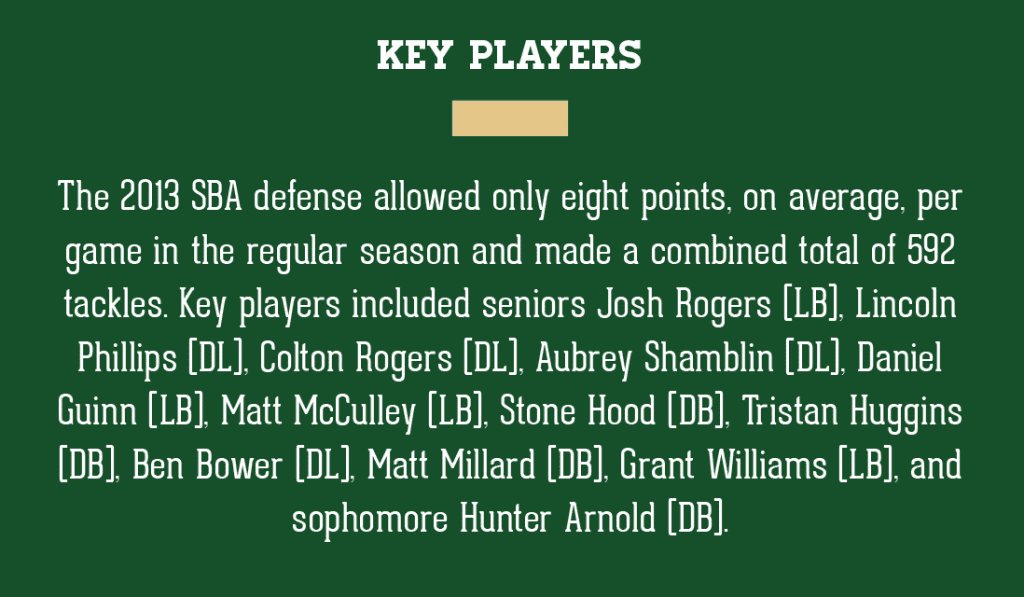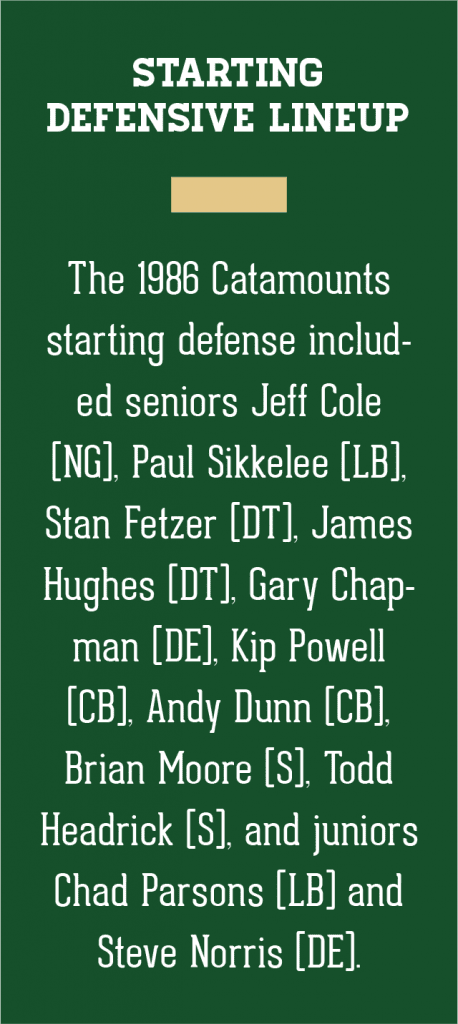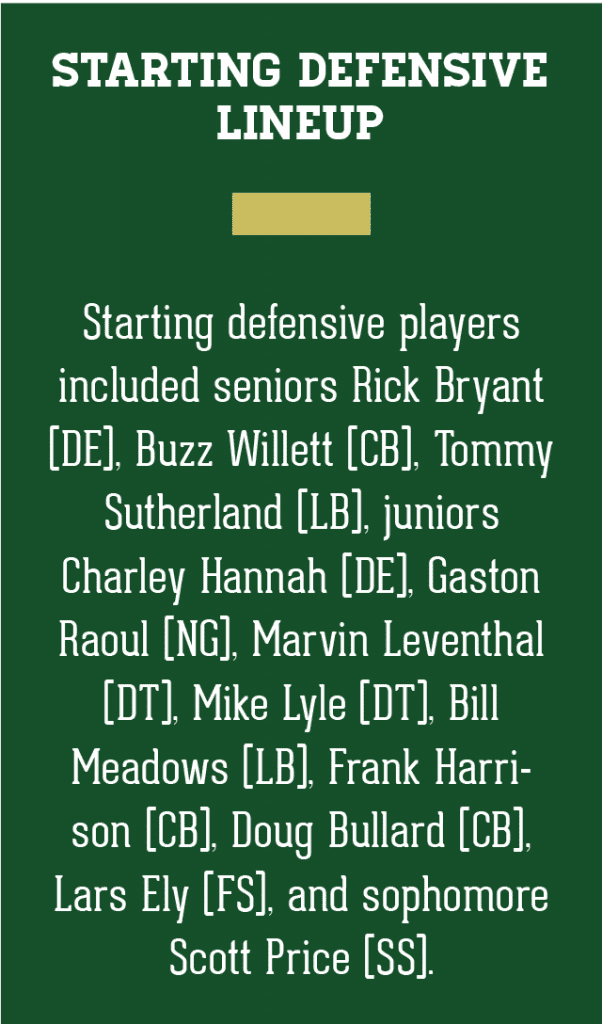(Above) Tristan Huggins, a defensive back on the 2013 Silverdale Baptist Academy team, celebrates during a game against Lookout Valley.
75 Years and Counting
The Greatest Defenses
Fourteen local high school football teams who held the line, forced turnovers, and shut their opponents’ offenses down
By Julia Sharp
It’s often said that the best offense is a good defense. The following 14 teams across 75 years had undoubtedly great offenses, but a major part of each season’s success is attributed to the skilled coaches and fierce defensive players who held opponents to staggeringly low scores each Friday night.
Shut it Down / Cleveland’s 1993 defense shut out opponents in six of 14 games.
1993 Cleveland
In 1993, head coach Benny Monroe led Cleveland to an astounding 14-0 record and state championship title, which the Blue Raiders maintained for three consecutive years. The defense held opponents to a mere 7.5 points per game on average, with six of their 14 games ending in shutouts. “You could take any individual out of this group and start building a defense around that one player,” Monroe says. “They were all just that good and made so many big plays.”
The defense was so outstanding, in fact, that no team scored a single touchdown until the sixth game when they faced Maryville. Monroe remembers the Maryville game well saying, “At the half, the score was about 28-21. We came back in the third quarter and scored five back-to-back touchdowns on five plays, which was crazy. We were up so much by then that I worried about scoring too much.”
Safety Dante Hickey was known for being a hard hitter. “You didn’t really want to go across the middle and try to catch passes with him back there at safety, because when he hit somebody, you could hear it all over the stadium,” Monroe says. Another outstanding hitter that season was Demetrius Smith, a great all-around athlete known for forcing turnovers.
Most of the starters were juniors and seniors who played on both sides of the ball, such as Chris Whaley (FB/ILB), Kevin Cobb (HB/CB), and Keith Cobb (HB/CB). With these double-threat athletes, Cleveland never had much fear of losing a game. “The championship game against Brentwood Academy was the first time we felt threatened, because they had dominated on offense all season. But we just absolutely shut them down, and the coach later told me that our defense was so unbreakable that he didn’t know what plays to call other than quarterback sneaks,” he adds. The Blue Raiders defense was so strong and imposing during the game, it intimidated the Brentwood Academy team, causing them to commit several penalties and turnovers.
“Our team never had a doubt we’d win the game, because Brentwood Academy just couldn’t muster anything offensively,” Monroe says. “I’ve said many times that I’ve coached a lot of great teams, but I’ve never had a team with more outstanding athletes on it than this 1993 team.”
(Above) Victory for the Bucs / Boyd Buchanan celebrates their state championship win over DCA.
2003 Boyd Buchanan
After a heartbreaking overtime loss in the 2002 state championship game, the Bucs had some unfinished business to take care of in 2003. They opened the season with fervor, trouncing Howard 52-6 and starting the journey back to the playoffs.
Head coach Robert Akins and defensive coordinator Grant Reynolds operated a 4-4 defense, comprised mostly of seniors. The starting lineup gave up an average of just 10 points per game. Middle linebacker Jeremy Davis led the defense on the field that year. “He wasn’t very big, but he played with a lot of heart,” says Reynolds, now a coach at Madison Academy in Alabama.
Although smaller in stature, the 2003 Boyd Buchanan team made up for their size with grit, toughness, and speed. “The kids played their roles well even though they might not have been directly involved with making the tackle,” Reynolds says. “They all really bought into our philosophy of being a swarm-like tackling defense.”
Dan Moore, who played defensive end on the 2003 team, also says that size never held this team back. “Every player had natural athleticism, but we also just had a lot of heart. We had great motivation, especially from our defensive coordinator coach Reynolds,” he says. “He would get so excited over big hits and overall great plays, which got our defense fired up. If he gave you a fist pump or the point from the sidelines, you knew you’d done well.”
Many fans still remember the legendary play made by the defense in the game against Lookout Valley. Moore and defensive tackle Robby Armstrong were on the field with the punt return team and were given the signal to go for a block. “I dove in to cause the block of the punt, and Robby scooped the ball up and ran it back for the touchdown,” Moore says. “It was awesome to cheer on one of my favorite teammates as he made the first and only touchdown of his high school football career.”
One of the Bucs most trying moments came in the state championship game against Donelson Christian Academy, a team that scored more than 35 points per game, on average. Despite being held to midfield during the first quarter, DCA managed to squeeze in a 30-yard field goal right before halftime, bringing the score to 3-0. “In the halftime meeting, we had several defensive players who stood up and said that if our offense can score just one touchdown, the defense is confident they can hold them,” Reynolds recalls. “And they were right. We scored 26 points and won the state championship title, but 7 would’ve done it.”
(Above) Dick Phillips receives a plaque citing his selection to Coach & Athlete Magazine’s High School All-American football team. Coach Etter (center) smiles proudly.
1962 Chattanooga Central
The 1962 Central Purple Pounders, led by legendary coach E.B. “Red” Etter, made history for the school when they achieved a perfect season for the first time. At the time, the TSSAA did not have state playoffs, and the Associated Press and United Press International polls decided champions. Both polls crowned Central the state champion.
Central’s schedule this year was notoriously tough. Out of 11 games, five were against teams who played in invitation-only bowl games. The difficulty didn’t deter the Central defense though, and the squad allowed just 4.5 points, on average, per game. Only two opponents managed to score more than 10 points. Defensive halfback Charles Sedman notes that if you count points allowed when the starting defense was playing, Central’s opponents only scored 20 points the entire season. “In other words, we had nine shutouts in 11 games,” Sedman says. After a two-touchdown lead, coach Etter would allow the scrubs (including me) in, and we gave up several fourth quarter touchdowns well after the outcome had been decided.”
Speed was a hallmark of this defense. “Eight of the 11 defensive starters were among the 10 fastest players on the team,” says Sedman. “Linebacker Dick Phillips was the standout leader. He just had a nose for getting to the ball,” says the team’s quarterback Harry Phillips. “Time and again, he would make the big play – instilling confidence and motivation in the rest of the team.”
Along with preparation and discipline, a healthy respect for coach Etter was the other key ingredient to Central football. “Each player’s respect for coach Etter was such that the greatest achievement wasn’t winning a state championship. It was making coach Etter proud,” says Dick Phillips. “It was coach Etter who masterminded defensive schemes and matched players to create a championship caliber defense. Coaches Stan Farmer and Jake Seaton recruited, grilled players on technique, and were master motivators,” says Harry Phillips.
Harry Phillips remembers a significant moment from the final season game. “Despite the frustration of an on-field brawl, the defense made a fourth quarter goal line stand to win,” he says. “That win ultimately determined the vote for state champion.”
1937 Dalton
The 1937 season ushered in a golden era for Dalton football as the Catamounts found a new coach in Homer Sutton. With a record of 7-0-1, this was the program’s first undefeated run and second district championship title. Sutton’s small but mighty defense allowed less than 3 points (2.375 to be exact) per game on average – the fewest since the program’s initiation in 1924. In fact, six of the eight games were shutouts, and no team was even able to score on the Catamounts until week four when Tyner put up just six points before ultimately getting smoked by offensive standout J. L. Putnam.
More than 1,000 fans packed into the stands at Harmon Field to watch the Cats play each Friday night. In fact, fans got so out of control during the game against Summerville, they ran onto the field for no apparent reason, according to Dalton football historian and current announcer Randal Davidson. This resulted in a 15-yard penalty for the Cats, but by a stroke of luck, Summerville fumbled the ball on the next play. That fumble led to Dalton’s second touchdown of the night, and they eventually won the game 19-0.
Although detailed records are hard to come by for defensive players from as far back as the 1930s, Davidson says Alfred “Snake” Anderson (DE) led the defense that year. One of Anderson’s greatest moments came in the 0-0 tie with the Cedartown Bulldogs, a powerhouse team that boasted a 4-0-2 record with both ties being scoreless games. “The Bulldogs had three tries from the Catamount one-yard line, only to be turned back and lose the ball on a fumble. An earlier threat was stopped when Alf broke through the line and threw a runner for a twelve yard loss,” Davidson says. After a standout high school football career, Anderson returned to Dalton and became a legend as head coach from 1947 to 1963.
Though coach Sutton had to replace seven of eleven starters the following year (1938), it didn’t stop Dalton’s momentum. The team continued its tradition of having a crushing defense, posting a 26-7-1 record for the remainder of the decade.
Head of the Hustlin’ Tigers / Head Coach George “Chubby” James led the team to a state title in 1960.
1960 Howard
By 1960, Howard School was in the middle of a 12-year winning streak that lasted from 1954 to 1965 with a 102-11-4 record. This season was no exception to Howard’s tradition of excellence, and the team was declared the No. 1 team in the state by the Tennessee High School Athletic Association for the second year in a row. Howard had a stalwart defense that gave up an average of just 4.18 points per game and an offense that scored 235 total points throughout the season, propelling the team to an amazing 10-0-1 record with six shutouts.
Nathanial Pinkard played tackle on the 1960 Hustlin’ Tigers team and recalls that the team worked well together due to their ability to listen, learn, and respect their leadership. In addition to head coach George James and the other members of the coaching staff, the team was led by captains Joseph Keith,
James Embry, and Willie Howard. “The defense stood out because of leadership from our coach and captains. These individuals kept us focused,” Pinkard says. “Our defensive coordinator Fred White brought out the best in each of us, and I credit a lot of our success to him because he knew what to do to motivate us,” he adds.
While most of the defensive players were hard hitters, one player stood out as being especially tough. Team captain Willie Howard was known for delivering game-ending, bruising hits to opposing players.
Pinkard says that thanks to their bone-crushing hits, the Hustlin’ Tigers 1960 defense was able to shut their opponents’ offenses down and keep Howard’s offense on the field. It wasn’t all smooth sailing though, as Pinkard recalls four challenging games against Parker (Birmingham), Pearl (Nashville), Father Bertrand (Memphis), and Burt (Clarksville). “These were the games of all games,” he says. “We could have easily lost, but our coaches, training, and the will to survive brought us through. We were taught to play as a team, and that’s exactly what we did in order to win.”

1963 Baylor
In 1963, Baylor School competed against football teams with 19- and 20- year-old postgraduate athletes who were repeating years of high school to make grades required to play football at certain colleges. Baylor didn’t have postgraduates, so that meant their 16- and 17-year-old students had to play at an even more competitive level, despite their youth. This obstacle never held the 1963 defense back, and they still allowed just 20 points over the course of the entire season for an average of 2.22 points per game.
Jimmy Brown was the 1963 team captain and primarily played running back, but he’d often step in as a defensive back as well. He recalls that Robert “Happy” Dicks and Chip Healy led the charge for the Red Raiders defense that season. Head coach Jim Worthington remembers that this team had a great work ethic, both on and off the field. “My greatest memory of Happy was that we’d get on the bus to go to an away game, and by the time the bus made it through the Baylor gates, he’d already have one of his textbooks out to study. He was so sharp, which also made our defense that much better,” Worthington says.
Under the leadership of coach Worthington, Baylor achieved a 9-0 record and shut out all but three opponents. “Jim was an outstanding coach with an unbelievable mind. He finally let us have water breaks, which we didn’t get in previous years, but that didn’t make practice too much easier,” Brown recalls. “We always said that games were almost like a break, because practices were so tough.”
The 1963 defense was known for being relentless. “During two-a-days, coach Worsham would take the linemen over for separate drills, and they were intense. As a back, you never wanted to get called out to go on the field with the linemen. That meant you’d done something wrong, and they were about to put you through it,” Brown laughs.
Brown and Worthington both agree that, while they had an outstanding team with a great defense, there was a little luck on their side as well. “Obviously if you go undefeated, you’ve got to have a little luck. We certainly had some of that along the way,” Brown says.
Dec. 5, 1997 / The 1997 Rams celebrate their state championship win over Union City.
1997 Tyner
After ending the 1996 season as state runner-up, Tyner Academy’s 1997 season culminated in a hard-earned state championship title. Head coach Wayne Turner utilized 5-3 and man coverage schemes to capitalize on the strengths of a very physical defense. This paid off, as the Rams achieved a 14-1 record with six shutouts and gave up just 8.4 points per game.
The defense was led by Mr. Football, senior middle linebacker Kelvin Hughley, and senior cornerback Windarek “Squeaky” Stewart. “Windarek Stewart had speed and elusiveness. He had that ability to break tackles,” says coach Turner. “Kelvin Hughley led by example. He worked hard in practice and demanded that from the other players,” says former Rams star quarterback and current assistant coach Jackie Buttram.
Senior safety Anthony Jones also led the area with the most interceptions that year (and that record hasn’t been broken yet), adding to the Rams’ record of 44 forced turnovers that season. “Aaron Ellison played with heart and soul, and Napoleon Clark played with a lot of grit – and he was a comedian that kept everyone loose,” coach Turner adds.
“During the offseason, they made a vow that they were not going to lose,” says Buttram. “They expressed that in game one against Boyd Buchanan.” On the first drive, Boyd scored a field goal, but after being “chewed out” by coach Turner, the Rams returned to the field determined to shut the Bucs offense out, which allowed their own offense to score 95 unanswered points for a 95-3 finish. “That was the moment we knew this defense was something special,” Buttram claims.
They showed their defensive prowess on the road to the state championship game. Coach Turner remembers several monster tackles Kelvin Hughley made during the quarterfinal game against David Lipscomb, and Buttram recalls the semifinal game against Harriman, “It was a hostile environment. The other team and fans were calling us names, but we answered them on the field by crushing Harriman 60-0.”
“When they were on the field, they were about business,” Buttram says. “They were relentless.”
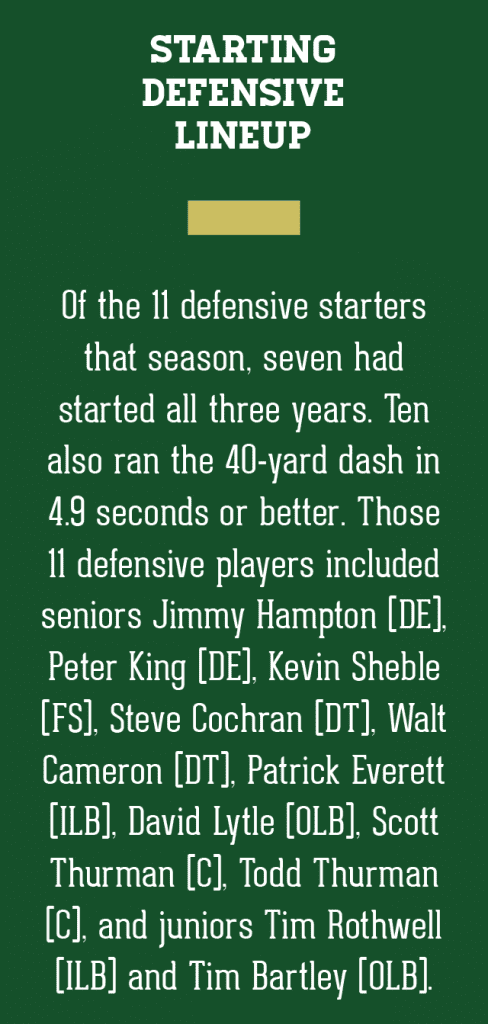
1984 Rhea County
Under head coach Bill Horton’s leadership, the 1986 Rhea County Golden Eagles became the No. 1 ranked team in Tennessee and No. 12 ranked team in the nation (USA Today). The defense gave up just 31 points during the regular season (an average of 3.1 points per game), with five shutouts against Cumberland, Bradley Central, McMinn County, Ooltewah, and Soddy Daisy. Not a single opponent managed to break into double digits.
The defense was led by inside linebacker Patrick Everett, who was known for spending his free time watching game film and learning new plays with coach Horton, defensive coordinator Tim Hammontree, and line coach Jerry Levengood, now current Rhea Co. superintendent. “Patrick was a great leader and knew the right calls to make at the right time, so all everybody else had to do was go play,” says Walt Cameron, a former teammate of Everett’s and current teacher and coach at Rhea County High School.
Cameron recalls that twin brothers Scott and Todd Thurman both played cornerback and could run the 40-yard dash in 4.5 seconds. He laughs saying, “The twins also wore glasses, and sometimes we’d have to call a timeout just so they could get their glasses cleaned after taking down some receivers.”
Micah Ruehling, Rhea County associate principal and athletic director, remembers the biggest hitter on the team was defensive end Jimmy Hampton. Despite standing at just 6’1” and 180 pounds, he was known for his crowd-pleasing, bone crushing hits. “All the fans would stand up when he went to block on a punt return so they could see how many big hits he’d have,” Ruehling says.
Andy Kelly, who played quarterback that season and would go on to join the Vols and then professional teams, remembers the 1986 defense well. “We knew offensively that if we ever struggled, the defense always gave us a chance. As a team, we felt 14 points a night would be sufficient, and even just a touchdown was fine on most nights. Once we got a lead, we knew it was typically over,” he recalls.
Some of the most memorable moments came when the Golden Eagles faced the other two top-ranked teams in Tennessee, Cleveland and Jefferson County. Cleveland was a long-time rival, but they were held to just three points while Rhea County put up 30. Jefferson County was ranked No. 2 at the time, but they were defeated handily with a final score of 31-6. “The defense gave Rhea County a chance to win every Friday night, and that’s all a fan base could ask for,” Ruehling says. “That team laid the groundwork for future seasons by sending the message that we were a physical team, and it made young kids want to play defense at Rhea County,” adds Cameron.
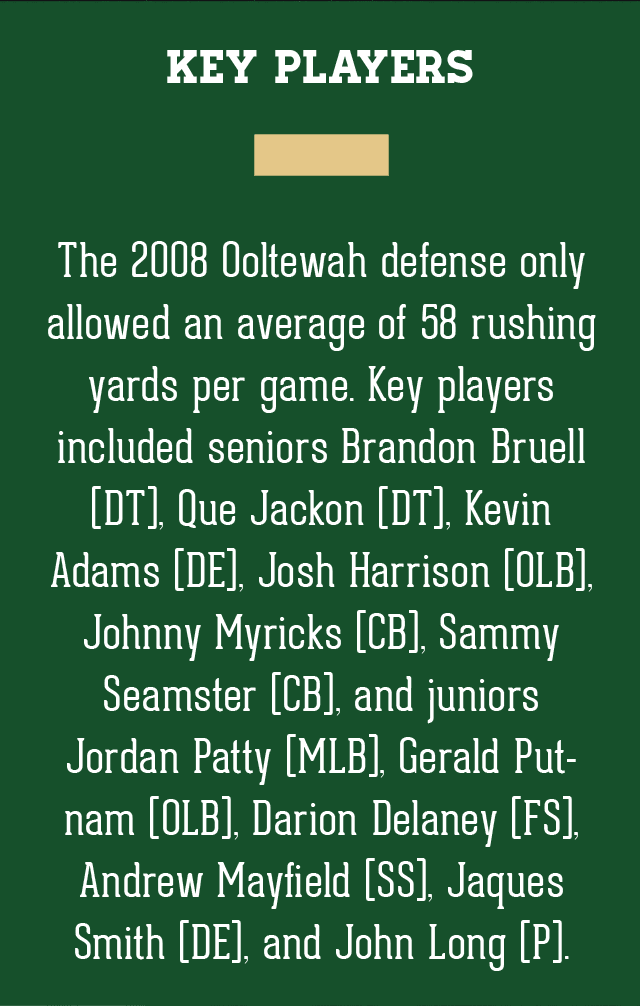
2008 Ooltewah
Running numerous defensive schemes including a 4-3, Bear front, and 3-4 package, the 2008 Ooltewah Owls’ defense allowed an average of just 7.4 points per game, while scoring 72 points through a combined 11 interceptions and fumble returns and 3 safeties. With 79 sacks, a total of 6 blocked punts and field-goal-attempts, and 15 fumble recoveries, this defense consistently disrupted opposing offenses and forced turnovers. “We could make big plays and change the game in an instant,” defensive coordinator Doug Greene says. “In the regular season, we scored more points on defense than the opponents scored on us. Our offense could have taken a knee in some games, and we still would have won.”
Defensive playmakers included junior Jacques Smith (DE), senior Que Jackon (DT), and senior Kevin Adams (DE). “Jacques Smith set the tone for the defense because he always played at full speed,” Greene notes. “Teams would double-team him, and then Que Jackson would make the big plays. Then they would run away from Que, and Kevin Adams would make big plays.” Junior Darion Delaney as free safety was the quarterback of the defense. “He made all the calls and checks to get us lined up,” Greene adds. “And junior Gerald Putnam led us in intensity. He was a great blitzer and a punishing tackler.”
Other key players included junior Jordan Patty (MLB) who was a sure tackler and a savvy cover guy. “He was able to get us adjusted to trick formations,” Greene notes. “Senior cornerback Sammy Seamster was quiet, but he could fly. He was able to completely eliminate the offense’s best receiver.”
The 2008 team really exemplified teamwork, according to coach Benny Monroe. The defensive mentality was that if they could stop the other team early, they knew the offense could score. “We took pride in creating turnovers and giving the offense good starting field position,” says Greene. “I loved watching them get excited about their teammate’s
big play.”
One of the season’s highlights was when Farragut first came to Ooltewah ranked No. 1 in the state, having not given up a sack all year. The Owls sacked the quarterback 12 times and knocked him down 29 times. The quarterfinal was another memorable game against Farragut, with the Owls down 7-6 at the half. “At halftime, we promised each other we would find a way to win even though the offense was struggling. On the second play of the half, Jordan Patty and Jacques Smith hit the running back in the backfield, stripped the ball, and ran it back to the 3-yard line. The momentum was ours after that,” Greene exclaims.
 1983 McCallie
1983 McCallie
In 1983, the McCallie defense allowed a miniscule 1.9 points per game, only giving up 21 points (3 touchdowns) over the entire regular season. Because no opposing team was able to get very far down the field, McCallie’s offense was set for success, scoring an incredible 220 points during the regular season. The team went undefeated with a 10-0-0 record and was named both District 6AAA and Region 3AAA champions in 1983. Out of 10 regular season games, a remarkable seven games were shutouts.
As the head coach, offensive coordinator, and defensive coordinator, coach Pete Potter had a direct hand in shaping the Blue Tornado defense. Bill Cherry, athletic director in 1983, remembers it well, “Coach Potter had a knack for taking the talent he was given and choosing the perfect formations in order to leverage their strengths.” Potter relied on a 50-style defense, or an “Oklahoma” defense.
Their defensive dominance stood out during the intense rivalry match-up with Baylor that year. McCallie held the Red Raiders to a sad, solitary first-down and a meager 47-yards rushing. The defense never allowed a Baylor player to make it past mid-field and helped the impressive offense put away 33 unanswered points. “At the time, that win was the largest margin of victory in the series,” Cherry says.
Running back John Green recalls, “As an offensive player, I felt much less pressure during a game knowing that we had our defense on the field with all their speed and intensity. They could intimidate and demoralize the opposing offense quickly. A lot of confidence comes from having a defense that just doesn’t give up much yardage or points and was as gritty and tough as they were. It freed our offense up to play more confidently with the backing of a determined, stingy defense.”
“We weren’t big, or fast, but we were hard hitters and were a really tight-knit group,” defensive end Mike Robinson remembers. Defensive back Ricky Taliaferro recalls, “We were a competitive group who were also really close friends. Fortunately, most of us had played as underclassmen, so by our senior year, we were seasoned. We were driven by our desire to not let our friends down.”
2013 Silverdale Baptist
Tough. Gritty. Hard-working. Tenacious. Crazy. These are the words head coach Al Rogers uses to describe Silverdale Baptist Academy’s 2013 defense. Making it further in the playoffs than ever before, this defense earned respect for the Seahawks football and athletics programs. The team had an 11-2 record, holding opponents to 14 points or fewer in eight of 13 regular and postseason games, and finishing the season with four shutouts. The defense gave up an average of just 8 points per game in the regular season.
Operating in a 4-2-5 or 4-4-3 scheme, the defense was led by seniors Josh Rogers (LB) and Colton Rogers (DL). “We had really good upperclassmen leaders, including All-District defensive MVP Colton Rogers. The defensive QB was Best of Preps and All-State linebacker Josh Rogers, who made all the defensive calls and coverage checks on the field,” says former defensive coordinator Tim Couch. Josh pounded out 131 tackles that season and had three interceptions. Overall, the defense forced 37 turnovers.
Senior All-State defensive end Lincoln Phillips was also named Best of Preps, and Rogers says he “was a dangerous threat coming off the edge and led the area in sacks, totaling 20.” Phillips also made 23 tackles for loss. Another key player was senior punter Michael Dellinger, who averaged an impressive 42 yards per punt.
Persevering through injuries was common for the Seahawks’ tough-as-nails 2013 defense. Phillips faced ankle trouble throughout the season, but he still managed to lead the team in sacks, nailing opposing quarterbacks an astounding 20 times. Colton Rogers also made 16 tackles for loss despite playing with a broken foot during seven games that season. “Colton and those seniors played hurt a lot of the time. Matt Millard had a broken finger, Josh Rogers dealt with hand injuries, Ben Bower had a bad shoulder, and Matt McCulley had ankle injuries,” coach Al Rogers says.
Couch recalls that the shutout game against Copper Basin set the tone for the season. “The defense created a turnover late in the game that resulted in a last-minute touchdown,” Couch says. “After that play, they all believed we had what it took to win.”
1986 Dalton
Led by coach Bill Chappell, the 1986 Catamounts achieved a perfect 10-0 regular season record for the second straight year. They delivered six shutouts, including their last four regular season games. Remarkably, the defense held all ten opponents to seven points or fewer, and they allowed an average of just 3.3 points per game.
The ’86 defense had four returning players: nose guard Jeff Cole, linebackers Chad Parsons and Paul Sikkelee, and tackle Stan Fetzer. New additions to the starting defense were James Hughes at tackle, Gary Chapman and Steve Norris at defensive end, Kip Powell and Andy Dunn at cornerback, and Brian Moore and Todd Headrick at safety.
Although the players on the 1986 team were smaller in stature than in previous years, they still managed to rack up an impressive number of significant tackles and turnovers. Dalton historian and current football announcer Randal Davidson recalls one example of a great defensive stand during the game against Cartersville. In that game, the Cats defense forced a turnover and held their opponent at the 14-yard line. “Sikkelee made a crushing hit on the opposing ball carrier, and Chad Parsons covered for Dalton. Then Chuck McClurg (QB) faked most of the defense out with a bootleg around the left end, and Greg McDonald’s (K) conversion completed the 14-0 victory,” he says. Along with Sikkelee and Parsons, the defensive charge was led by secondary stalwarts Kip Powell and Todd Headrick.
Of their first playoff game against Lafayette, Davidson recalls, “It was Dalton’s defense that carried the night.” The offense was struggling with strep, the flu, and several injuries. However, they came back from a Lafayette lead of 3 and finished out the game after defensive end Kip Powell picked up a Lafayette fumble and set up Greg McDonald for a field goal. The Catamounts lost their second playoff game, ending the season with an overall record of 11-1.
2006 Red Bank
The 2006 Red Bank team was in the middle of a five-year run of district championships, which included two undefeated regular seasons and five straight playoff appearances. This ’06 team, however, brought an entirely new level of physicality and athleticism. Boasting eight total shutouts, not one point was given up at home all season long.
The defense this season was stacked. “Tracy Sims was a physical linebacker and punishing playmaker overall,” current Red Bank coach Matt Bowman recalls. Jeremy “Ta-Ta” Caldwell, a defensive back, was known for being a game-changer in the backfield. “He was overall the best athlete,” remembers coach Bowman. Tim Benford was a hard hitter on the defensive line. “Benford had a physical defensive back presence. He hit hard,” adds Bowman. Another hard hitter, Miguel Sanchez, was dominant on the line. “He was the hardest hitter on the field,” Bowman notes. Taylor and Tyler Chambers, both defensive lineman, also contributed to this tough defense.
Coached by Tim Daniels, with defensive coordinator Kenny Cobbles, Red Bank’s overall record was 12-1 in 2006, only losing in the state quarterfinals to Maryville. In addition to never giving up a point at home, only three teams scored more than 10 points against Red Bank’s defense. They allowed an average of just 5.38 points per game, all season long.
“With multiple college signees and two future NFL players in Tim Benford and Ta-Ta Caldwell, this team was something else. I believe they had over 40 sacks that year and over 25 interceptions,” Bowman says.
(Above) Defensive end Charley Hannah (80) surprises Bradley Central with a jarring tackle.
Mike Lyle (77) and Rick Bryant (84) lead an intimidating pass rush against Bradley Central.
1971 Baylor
Prior to 1971, head coach E.B. “Red” Etter had all athletes play on both sides of the ball, and there were no separate practice teams led by defensive and offensive coordinators. That changed during the 1971 season when he split the team, naming each athlete to either offensive or defensive positions. Red Etter’s son Gene Etter was promoted to defensive coordinator, while Red still managed the offense. “He’d always done it by himself before, but this change was a gamble that worked out greatly,” Gene Etter recalls.
Baylor experienced a “Golden Age” of defenses in the early ‘70s, but the 1971 season stands out because many of the games went down to the wire. “Many games during the incredible 1972 and 1973 seasons were one-sided, which didn’t require great defensive games,” Etter says. In six of the ten ’71 games, a single touchdown could’ve caused a Baylor loss. However, the defense held opponents to a scant 6.7 points per game on average, with three games ending in complete shutouts. None of Baylor’s opponents could muster more than 16 points on the scoreboard, and only three teams were able to score two touchdowns. “Red’s Raiders,” as they were affectionately known, finished the season posting a 9-1 record.
The defensive QB and leader on the field was linebacker Tommy Sutherland, who was known for challenging his teammates and encouraging their best efforts. “Howie Long once said that Lyle Alzado
had two moods – pissed off and almost pissed off. I think Tommy fit that description as well,” recalls Charley Hannah, former 1971 Baylor defensive end. “The vocal leader was our nose guard, Gaston Raoul,” he says. “His humor was nonstop the whole game. I don’t know how Tommy didn’t elevate past ‘almost pissed off’ with him, but Gaston just made sure playing was fun,” he adds.
Etter recalls one unforgettable play by defensive end Rick Bryant. “The hardest hit I saw all season was when a McCallie back tried to get around Rick Bryant,” he says. “Rick stood him up, with Tommy Sutherland and Mike Lyle coming hard to finish it up.”
Cornerback Buzz Willett remembers how the team slowly began to realize just how great their defense was. “The realization happened slowly at first, starting when we shutout Kirkman and beat McCallie 9-7 after stopping them by inches on their last drive on fourth down. We really started believing in the power of our defense after we edged Oak Ridge 7-6,” he says. Free safety Lars Ely adds, “Steve Tipps (QB) told us we could beat Oak Ridge if we played hard enough, and that win made our defense realize how good we could be.”
The 1971 season set a new standard for Baylor football. “Victories over teams that typically trounced Baylor changed us. Gaston loved to remind everyone that we weren’t going to lose on ‘our’ field. We’d crawled from sideline to sideline pulling weeds during training camp, and there was no way we’d let another team beat us on that turf,” Hannah laughs.







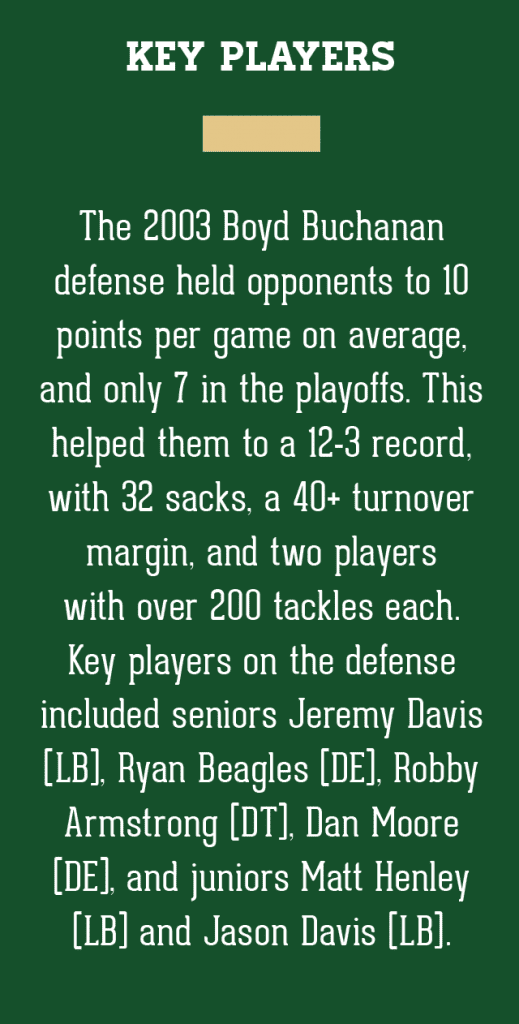


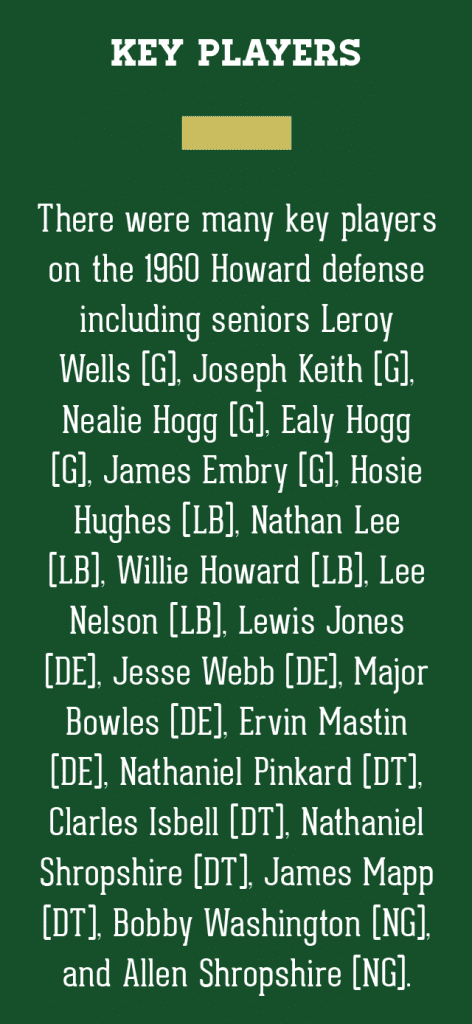

 1983 McCallie
1983 McCallie